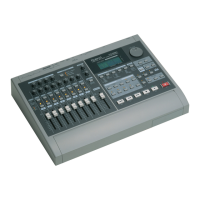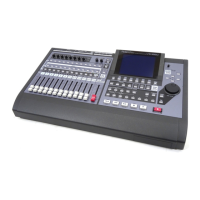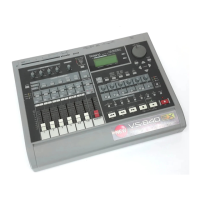23—MIDI and Synchronization
300 www.Roland.com Roland VS-2000 Owner’s Manual
7. Set Sync ERROR LEVEL to adjust the VS-2000’s tolerance of dropouts in the time
code. Lower values make the VS-2000 less tolerant of time code problems, causing
it to cancel synchronization by stopping the VS-2000’s hard disk recorder. Higher
values make the VS-2000 more patient with problems in the time code, giving it
more time to recover before canceling synchronization.
8. Complete the setup by configuring the master device so that it’s set to:
• send MTC to the VS-2000’s MIDI IN jack.
• the same frame rate as the VS-2000.
• generate MMC.
• transmit SysEx data.
Starting Synchronized Playback with the VS-2000 as Slave
1. Press PLAY on the VS-2000—its indicator flashes green to indicate that it’s awaiting
external time code.
2. Start playback on the master device—the VS-2000 follows suit. If you’ve shifted the
project start time, the VS-2000 now line jumps to the desired location.
3. To halt playback, stop playback on the master. If you’ve shifted the project start
time, the VS-2000 now line jumps to its actual MTC/SMPTE time code location.
Shifting the Project Start Time
It’s not uncommon to be syncing a VS-2000 project to material on a master device that
doesn’t begin at 00h00m00s00f00 MTC/SMPTE time. You might be syncing the project
to a song somewhere in the middle of a digital tape, for example. When you begin
playback, the VS-2000’s now line shoots ahead to the same time location—the
beginning of the material on the master starts in the middle of the VS-2000’s project.
If you’ve already recorded at the beginning of your project, it won’t play along with the
master’s material. If you haven’t yet recorded on the VS-2000, any audio you record
during synchronization will begin somewhere within the project. When you want to do
unsynchronized work, you’ll need to navigate to the middle of the project to begin
playback each time instead of just being able to hit the ZERO button.
You can shift, or “offset,” the project’s start time to solve this problem so that whenever
the master starts over, your project begins at the top.
The best setting for the both the SYNC with GAP and Sync ERROR LEVEL parameters
is a personal judgement call. When SYNC with GAP is turned off and SYNC ERROR
LEVEL is set to a lower value, you can be sure that your sync is rock-solid when
synchronization is successful. On the other hand, it’s more likely that synchronization
will fail. If you turn SYNC with GAP on and use a higher Sync ERROR LEVEL value,
it’s more likely that synchronization will succeed, but it may not be as tight. You may
need to experiment with various settings to find the one that’s most satisfactory.
Consult the master device’s documentation for synchronization setup details.
If the time code produced by the master device starts before 00h00m00s00f00—that is,
it’s a negative value—the project playback on the VS-2000 pauses at 23h.59m.59s.29f.99.
Be sure not to record any audio in the project at this time location.
Sync-related parameters can’t be adjusted while the PLAY indicator is flashing.
VS2000OMUS.book 300 ページ 2004年10月20日 水曜日 午後3時3分

